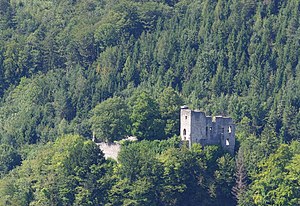Karlstein castle ruins
| Karlstein castle ruins | ||
|---|---|---|
|
Karlstein ruins as seen from the mayor's height |
||
| Creation time : | shortly before 1150 | |
| Castle type : | Höhenburg, summit location | |
| Conservation status: | ruin | |
| Place: | Bad Reichenhall - Karlstein | |
| Geographical location | 47 ° 43 '7 " N , 12 ° 50' 27" E | |
| Height: | 615 m above sea level NHN | |
|
|
||
The castle ruin Karlstein is a castle ruin on a rock in the Bad Reichenhaller district Karlstein in the district of Berchtesgadener Land in Bavaria .
The ruin is registered as an architectural monument in the Bavarian list of monuments, medieval and early modern artefacts are noted as soil monuments.
Geographical location
The ruin of the summit castle is 615 m above the Thumsee on a steep rock and can only be reached on the last section of a hiking trail via a long metal staircase. In front of the castle ruins is today the cath. Pilgrimage Church of St. Pankraz . In place of this Baroque built in the years 1687-1689 the chapel Pankraz rock was probably in the Middle Ages a bailey .
On the north flank of the rock, directly below today's castle ruins, there were numerous dwellings from the Bronze Age , which are part of the prehistoric settlement areas of Karlstein . On the Haiderburgstein, which rises northeast of the church of St. Pankraz, dwellings from the Bronze and Urnfield Ages were found. Presumably the area in which the castle is located was also inhabited at that time. However, since the area was built over in the Middle Ages, there is no archaeological evidence.

history
Konrad von Peilstein had the fortification built shortly before 1150. The Peilstein family, who are based in Lower Austria , probably followed a call from the Archbishop of Salzburg, who had appointed the Peilstein Count as his secular representative in court (Vogt). Towards the end of the 12th century, a castle captain named "Karl" lived here, after whom the entire complex was probably named. The castle was first mentioned in a document in 1208.
In 1218 Karlstein came to the Bavarian Duke, who from then on entrusted the maintenance of the castle to his servants. Since the end of the Middle Ages, Karlstein had lower jurisdiction over a larger neighborhood, the so-called Hofmark . The Bavarian Duke gave Burg and Hofmark Karlstein to Reichenhall patricians or high-ranking officials who were looking for a place of residence appropriate to their status for life in return for appropriate payments. Under the powerful Fröschl von Marzoll and Tauerstein family, the castle was converted into a palace and remained in this form until it fell into disrepair at the end of the 17th century.
The generously designed round arched gate has been preserved from this late period. Next to it rose as an elongated building with a retracted rectangular gate, which was dedicated to St. Andreas castle chapel . Just as the chapel was built when the castle was built, the surrounding wall also dates from before 1150. In the west of the castle, the heavily dilapidated outer wall was torn down in 1671.
In the middle of the castle complex there are still the remains of an almost square cistern in which the rainwater was collected. At the highest point of the courtyard stands a round tower with a -, the high input equipped - the function of the keep filled. It dates back to the first half of the 13th century, i.e. the time when Karlstein passed into the possession of the Bavarian Duke.
After being closed to the public for a long time, the Bavarian State Forests, as the owner of the castle, carried out a fundamental renovation of the complex in accordance with historical monuments from July to mid-December 2012. A 6 m² hole in the western wall was closed, the walls repaired and partially supported and the plaster was renewed in many places. The tree growth inside the castle walls and outside on the rock was partially removed, the lintels were reinforced with new oak planks and the footpath to the castle was repaired or relocated in places.
literature
- Werner Meyer : Castles in Upper Bavaria - A manual . Verlag Weidlich, Würzburg 1986, ISBN 3-8035-1279-4 , p. 56-57 .
- Johannes Lang : Reichenhaller Burgenweg . Association for local history Bad Reichenhall, 2004.
- Hubert Vogel: From the four thousand year old Karlstein - history and farm history . Munich 1973.
- Herbert Pfisterer: Bad Reichenhall in its Bavarian history . Motor und Touristik Verlag, 1988.
Web links
- Castle ruin Karlstein on "House of Bavarian History" (plans, history, building history, building stock)
- BGL Wochenblatt: Illustrated report on the renovation work




